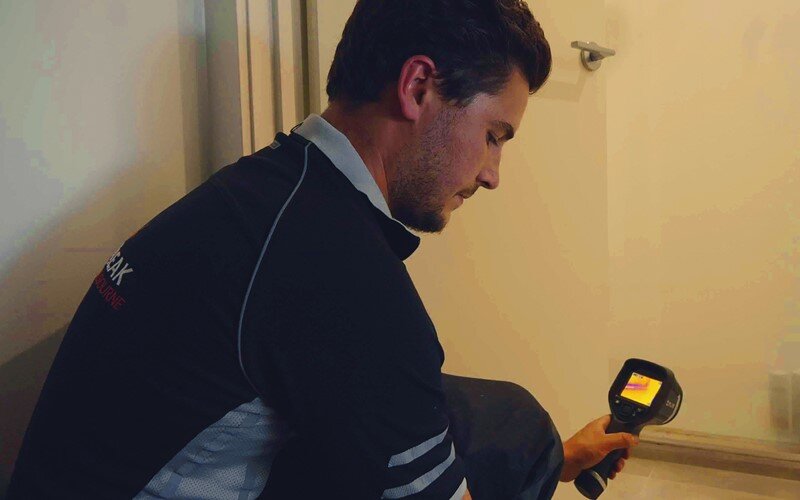The writer is making a few great observations on Detecting hidden plumbing leaks overall in the content underneath.

Early discovery of dripping water lines can alleviate a possible catastrophe. Some small water leakages may not be visible.
1. Take A Look At the Water Meter
Every residence has a water meter. Examining it is a surefire way that assists you find leakages. For beginners, turn off all the water resources. Make certain nobody will flush, make use of the faucet, shower, run the washing machine or dishwasher. From there, most likely to the meter and also watch if it will certainly transform. Because nobody is utilizing it, there must be no motions. If it relocates, that shows a fast-moving leakage. If you discover no adjustments, wait a hr or two as well as check back again. This implies you might have a slow-moving leakage that could also be underground.
2. Examine Water Intake
Analyze your water costs as well as track your water consumption. As the one paying it, you should discover if there are any kind of disparities. If you detect sudden changes, despite your intake coinciding, it indicates that you have leakages in your plumbing system. Remember, your water bill ought to drop under the very same range every month. An unexpected spike in your costs suggests a fast-moving leak.
At the same time, a steady boost monthly, despite having the very same habits, shows you have a slow leakage that's also gradually intensifying. Call a plumber to thoroughly inspect your building, specifically if you really feel a cozy area on your floor with piping beneath.
3. Do a Food Coloring Test
When it pertains to water consumption, 30% originates from bathrooms. Examination to see if they are running appropriately. Decrease flecks of food shade in the tank and also wait 10 minutes. If the shade in some way infiltrates your bowl during that time without flushing, there's a leak in between the storage tank and also dish.
4. Asses Outside Lines
Don't fail to remember to check your outside water lines as well. Examination spigots by connecting a garden hose. Needs to water permeate out of the link, you have a loosened rubber gasket. Change this as well as make certain all connections are tight. If you've obtained an automatic sprinkler, it will certainly assist get it properly took a look at as well as preserved annually. One little leakage can squander lots of water as well as increase your water costs.
5. Inspect and also Analyze the Scenario
Home owners need to make it a practice to examine under the sink counters as well as also inside cupboards for any kind of bad odor or mold and mildew growth. These two red flags suggest a leakage so timely interest is needed. Doing routine inspections, also bi-annually, can save you from a significant trouble.
Check for stainings and deteriorating as a lot of pipelines and also home appliances have a life expectancy. If you believe leaking water lines in your plumbing system, do not wait for it to escalate.
Early discovery of dripping water lines can alleviate a prospective disaster. Some little water leaks might not be noticeable. Examining it is a surefire method that aids you discover leaks. One little leakage can lose tons of water and spike your water costs.
If you suspect dripping water lines in your plumbing system, don't wait for it to escalate.
How to Know If Your Home Has a Hidden Leak
Water Meter Reveals Inexplicable Water Usage
If you’d like to test whether or not there’s a leak somewhere in your home, you can do this using your water meter. Here is how to conduct the test:
Don’t use any water in your home for at least 30 minutes; this also means not turning on faucets or water-using appliances.
Go outside, and check your water meter for activity.
If your water meter shows that there was activity, even though no one was using any water, this proves that there is a leak in your home.Visible Mold or Mildew Growth
Leaks behind walls create moist, dark environments that allow mold and mildew to grow and thrive. Eventually, you might see mold growth forming on the wall closest to a hidden leak.
If mold is growing in an area that receives a high amount of moisture, such as a bathroom, it may simply be an indication that better ventilation is needed. However, if you see mold growth on a wall or the ceiling in an area where you would not expect, you probably have a hidden leak.
Musty, Mildew Odor
Sometimes you might not be able to see the mold or mildew that is growing as a result of a leak. However, the smell can give the problem away just as easily. If you catch a whiff of something musty, there’s a good chance that old water is collecting somewhere in your home that you can’t see.
Stained/Warped Walls, Ceilings, or Floors
When your home soaks up water, a variety of red flags can become visible, including ceiling stains, bubbling drywall, warped walls, and sagging floors. While these issues can be caused by excess humidity, they can also be signs that a pipe or plumbing connection has started leaking behind your walls.
Inexplicably High Water Bill
After a while, you get a general sense for what your water bill should be. If you own a pool or sprinkler system, your bill will tend to be higher during summer. However, if you receive a water bill that seems especially high, and you can’t figure out what caused it, then you may have a hidden leak somewhere that’s increasing your bill.
https://www.plumbingjoint.com/blog/2019/july/how-to-know-if-your-home-has-a-hidden-leak/

I discovered that blog entry about Detecting hidden plumbing leaks while browsing on the web. Are you aware of somebody else who is very much interested in the topic? Why not share it. I take joy in reading our article about Leaking water lines.